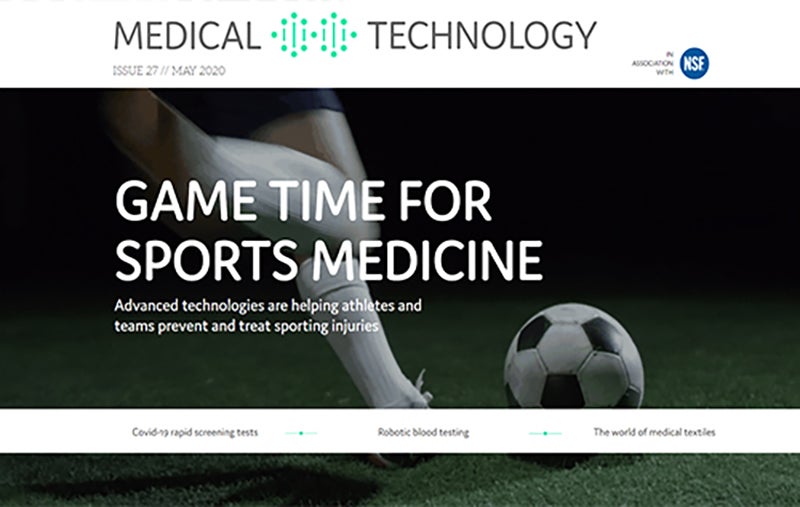
Medical Technology is now available on all devices. Read it for free here
In the ongoing struggle to find and develop vaccines, cures and treatment options for health problems, one piece of medical equipment has stood the test of time as the best friend of medical researchers: the microscope. To understand its importance in the medical field, we track the use of the microscope throughout history. Returning to the present, we find out how Covid-19 has brought companies together to produce rapid screening tests in an effort to help control the spread of the virus.
Also in this issue, we take a look at the role that medical devices play in professional sports, investigate the potential of robotics in blood testing, and get to grips with a mechanical controller design that combines the two types of gripping used in commercially available robotic surgery systems.
Plus, we unpick the complex world of medical textiles to examine the most interesting and innovative materials being used to suture wounds and repair damaged tissue, find out how the geko wearable device from Sky Medical Technology uses painless electronic stimulation to prevent and treat blood clots, and take a look at the findings of CyberMDX’s ‘2020 Vision Report on healthcare cybersecurity’.
All this, plus the latest trends, insight and analysis in medical devices and technologies from GlobalData.
How well do you really know your competitors?
Access the most comprehensive Company Profiles on the market, powered by GlobalData. Save hours of research. Gain competitive edge.

Thank you!
Your download email will arrive shortly
Not ready to buy yet? Download a free sample
We are confident about the unique quality of our Company Profiles. However, we want you to make the most beneficial decision for your business, so we offer a free sample that you can download by submitting the below form
By GlobalData
In this issue
Timeline: under the glass of the microscope
A lot has changed since the late 16th century when father-son scientist duo Hans and Zacharias Janssen invented the world’s first compound microscope. But how has microscope technology developed over the past decade, and what have the ramifications been for human health? Chloe Kent finds out.
Read the article here.
Different paths to the same destination: screening for Covid-19
At present, polymerise chain reaction and antibody testing are the dominant ways that global healthcare systems are testing citizens for Covid-19. Both techniques have their caveats, and as the crisis unfolds researchers are looking into alternative ways to screen for the deadly disease. Chloe Kent looks into the science behind existing tests, and what alternatives are starting to present themselves.
Read the article here.
Enhancing recovery: the rise of medical technology in sports
Physical health has always been a core issue in professional sports, a field where injuries are commonplace. Now, medical technology is being used to monitor and enhance athletes’ recovery.
Chloe Kent takes a closer look.
Read the article here.
Is the future of blood testing robotic?
A robot beat healthcare professionals in the first clinical trial of an automated blood-drawing and testing device. Natalie Healey meets the prototype’s creator, Rutgers University’s Martin Yarmush.
Read the article here.
Get a grip: designing mechanical controllers for robotic surgery
Scientists at Tokyo Institute of Technology have designed a new type of controller for the robotic arms used in certain kinds of laparoscopic surgery. By combining the two distinct types of gripping used in commercially available robotic systems to leverage the advantages of both, they believe their technology will reduce physical strain on surgeons while providing good precision. Chloe Kent finds out more.
Read the article here.
Medical textiles: scientists spin a good yarn
What if damaged body parts could be repaired with textiles grown and sewn from human cells? Scientists at INSERM are exploring this aspect of regenerative medicine. Natalie Healey speaks to director of research, Nicolas L’Heureux.
Read the article here.
Geko: a painless way to deal with leg blood clots
Sky Medical Technology’s geko™ device uses painless electronic stimulation of the calf muscles to increase blood flow in the leg. The device stimulates the peroneal nerve and pumps the muscles in the calf and foot, which gets things moving deep in the veins. Designed to help prevent blood clots, heal ulcers and reduce swelling, how does the geko work and what impact is it having in hospitals today? Chloe Kent finds out.
Read the article here.
The hacker will see you now: the vast scale of medical device cyber insecurity
Medical devices connected to a hospital network are extremely vulnerable to cybersecurity attacks, according to a report by CyberMDX. This puts patients’ data and sometimes their lives at risk from hackers and cyber criminals. Allie Nawrat finds out more.
Read the article here.
Next issue preview
In the next issue of Medical Technology, we investigate the shocking rise and fall of electrical aversion therapy in the US after the FDA banned the use of electrical stimulation devices to treat self-injurious or aggressive behaviour in neuroatypical patients earlier this year. Plus, we examine the lure and danger of coronavirus home testing kits.
Also, we find out how a collaboration between the Rwandan Government and Babylon Health put Rwanda on track to become the first nation in Africa with a digital-first universal primary care service, take a look at the tech driving innovation in smart ambulances, and examine what manufacturers can learn from the science of ‘super sniffers’.
Plus, we find out how technology is helping to prevent infection at surgical wound sites, explore the digital future of ophthalmology, and ask if an artificial pancreas could be a game-changer for diabetes research.




